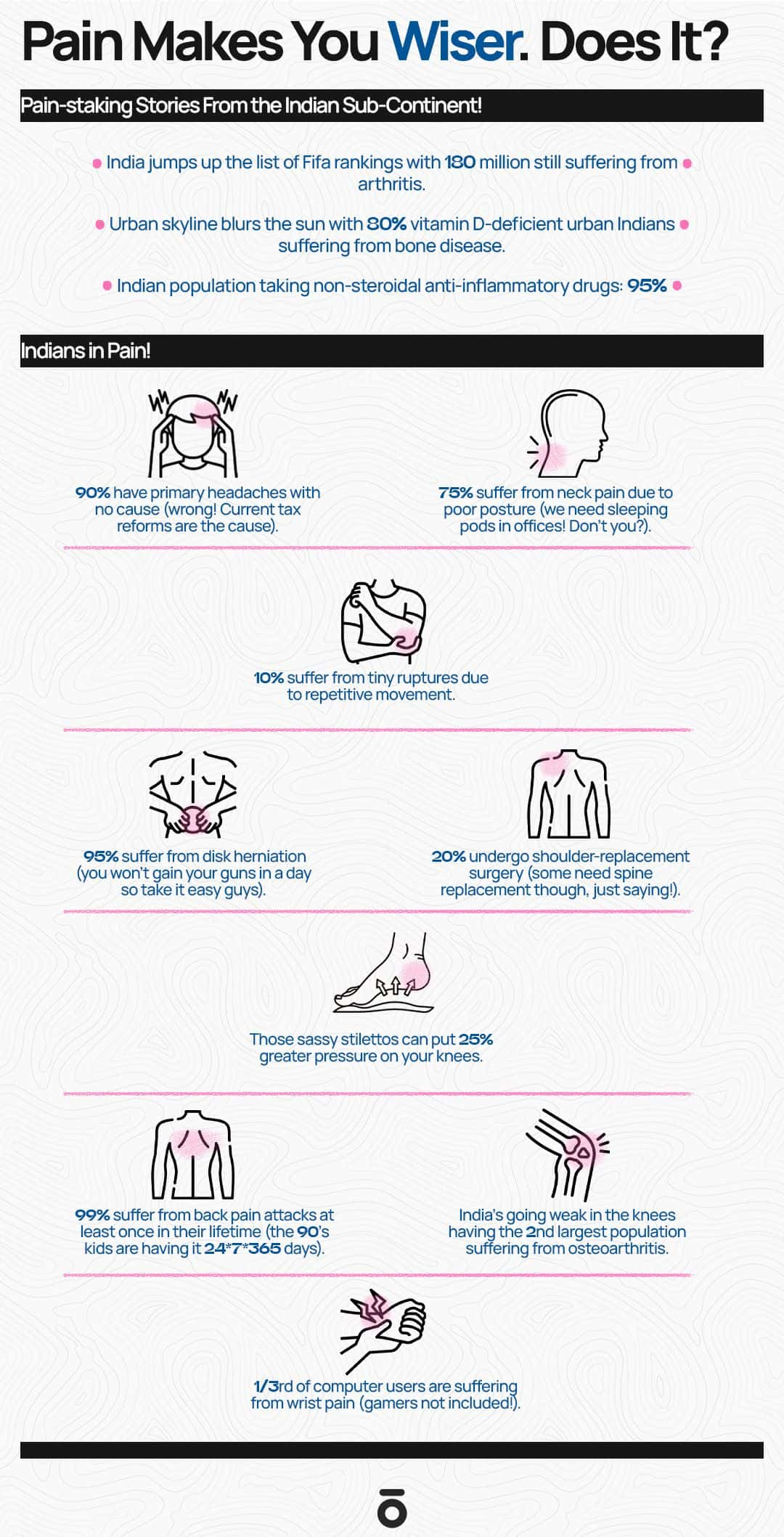Understanding Chronic Pain: Causes, Effects, and Solutions

Introduction
Have you ever randomly woken up in the middle of the night because your limbs just hurt so bad? Has it been happening with increasing frequency for almost half a year? If this has never happened to you, then congratulations, you never had the displeasure of intimately knowing what chronic pain is.
For those of us who are unfortunate to have lived this, we know that chronic pain is agony distributed throughout our life, to spike at the most inopportune moments. It is a complex and often misunderstood condition that affects millions of people worldwide, including a significant number in India. Only that not many even know they're feeling chronic pain.
Unlike acute pain, which is a temporary response to injury or illness, chronic pain persists for months or even years, significantly impacting your quality of life. Kofuku is here to make you aware and explain the exact causes of chronic pain so you, too, can figure out whether that unexplained constant twinge in your neck is a lifelong companion or something temporary.
What Constitutes Chronic Pain?
Chronic pain is known as pain that lasts longer than three to six months, often continuing even after the underlying cause has been treated or resolved. According to a survey conducted in India, the prevalence of chronic pain among adults is estimated to be 19.3%, with a higher prevalence in females at 25.2%. Unsurprisingly, the difference is mainly because women are more prepared to acknowledge the pain than men. Apart from the toxic masculinity, this statistic also highlights the significant health issue chronic pain represents in the Indian population.
The effects of patriarchy aside, let's get to the good stuff: how do you figure out if you have chronic pain that needs managing pronto?
Symptoms of Chronic Pain
Does any of the following seem eerily familiar to you?
- Persistent aching or stiffness in muscles and joints
- Sharp, shooting, or burning sensations
- Pain that radiates to other areas of the body
- Fatigue and sleep disturbances
- Mood changes, including anxiety and depression
Then you might have chronic pain! (Visit your doctor as soon as possible)
Causes of Chronic Pain
Chronic pain can arise from various sources, including physical injuries, medical conditions, and psychological factors. Here are some of the most boring but not any less painful common ways it can manifest:
1. Mental Health Factors
Chronic pain and mental health have a very special relationship. In that, they end up being comorbid almost all of the time. Conditions like depression and anxiety can amplify one's perception of pain and contribute to its persistence.
Studies indicate that over 67% of individuals with chronic pain also experience comorbid psychiatric disorders. That's almost close to a perfect number (of people).
2. Fibromyalgia
Now, this right here is literally pain. Nobody is doing it like her. Let us introduce you to Fibromyalgia, a chronic condition characterised by widespread musculoskeletal pain accompanied by fatigue, sleep disturbances, and cognitive difficulties. Woo! Can anyone even handle all that, you may ask?
But you'd be surprised to know it affects about 0.5-2% of the Indian population, with women being affected three to seven times more than men. The exact cause of this chronic pain remains unclear, but it is believed to involve abnormal processing of pain signals in the brain.
3. Other Causes
Chronic pain can also result from various other conditions, including:
- Arthritis (rheumatoid arthritis and osteoarthritis)
- Back injuries or conditions (e.g., herniated discs)
- Nerve damage (e.g., diabetic neuropathy)
- Cancer-related pain
- Inflammatory bowel disease (IBD) and irritable bowel syndrome (IBS)
- Endometriosis
Of course, a damaging enough accident could end up resulting in chronic pain long after the recovery period is over.
The Reality of Living with Chronic Pain
Living with chronic pain is often an invisible battle that many people face daily. It can feel like mosquitoes on a sleepless night, affecting not just the body but also the mind and spirit. For those who suffer, each day can bring a mix of hope and frustration as they try to get through their routines.
Dysfunction: One of the most hard-hitting things is that it's every day. EVERY DAMN DAY. The pain, although differing in intensity, is still present every day, and simple tasks that others take for granted - like getting out of bed, cooking a meal, or even enjoying a walk - can become their own herculean tasks.
Chronic pain can limit mobility and hinder participation in work or social activities, leading to feelings of helplessness and social isolation.
Sleep Issues: Many individuals find that pain disrupts their sleep patterns, making it difficult to achieve restorative rest. Fair enough. Nobody is sleeping through a thousand tiny pins poking into their shoulder or hip. The exhaustion from sleepless nights can compound the pain, creating a vicious cycle that leaves them feeling drained and overwhelmed.
Fatigue: Chronic pain often comes hand-in-hand with fatigue, leaving individuals feeling physically and mentally exhausted. This fatigue can make it difficult to engage in daily activities or maintain relationships, leading once again to isolation and loneliness.
Quality of Life: The emotional toll of chronic pain can be profound. It can affect mental health, leading to anxiety and depression as individuals grapple with their condition. They may feel misunderstood by friends and family who cannot fully grasp the extent of their suffering.
When we talk about the reality of living with a constant close to agonising pain, we really do mean it.
Is Chronic Pain Considered a Disability in India?
Chronic pain is increasingly recognised as a significant health issue in India after a lot of awareness drives, but a disability? That seems to be a bit more nuanced than what we can take.
In India, the Rights of Persons with Disabilities Act 2016 expands the definition of disabilities and includes various conditions that can be classified as disabilities. However, chronic pain itself is not explicitly listed as a disability under this act. The act recognises disabilities that result in substantial restrictions on daily life. But chronic pain often falls into the category of "invisible disabilities”.
According to the Ministry of Social Justice and Empowerment, a disability certificate is issued when an individual has a disability of 40% or more. Even though chronic pain can lead to significant limitations in daily activities, it may not always meet this threshold unless accompanied by other conditions that impact physical function or mobility.
So the question again is: Should chronic pain be considered a disability?
Chronic pain’s impact on daily life is inarguable. It limits the ability to maintain employment, engage socially and even do simple day-to-day tasks. Many experience debilitating symptoms that affect their quality of life. Oftentimes, it does not even manifest physically, making it difficult for others to understand the extent of the suffering. This invisibility can lead to stigma and misunderstanding, further complicating access to necessary support and accommodations.
Recent conferences and initiatives, like the 2024 National Conference on Invisible Disabilities in Goa, show the need for increased awareness and understanding of conditions like chronic pain. Better recognition can lead to improved healthcare policies and support systems.
Chronic Pain Treatment Options
Knowing what we know so far about chronic pain, it should be clear by now that various treatment options need to be taken into account. By knowing the underlying cause a combination of approaches can be considered as a solution.
1. Medications
-
Over-the-Counter (OTC) Pain Relievers: Nonsteroidal anti-inflammatory drugs (NSAIDs) like ibuprofen and acetaminophen.
-
Prescription Medications: Opioids for severe cases; however, these come with risks of addiction.
-
Antidepressants: Certain antidepressants have been shown to reduce chronic pain symptoms.
2. Physical Therapy
Can help improve mobility and strength while teaching how to better cope with chronic pain.
3. Cognitive Behavioural Therapy (CBT)
CBT helps individuals change negative thought patterns related to their pain experience, promoting better coping mechanisms.
4. Natural Remedies
-
Acupuncture
-
Yoga and mindfulness practices
-
Herbal supplements (e.g., turmeric for inflammation)
Chronic Pain Support Groups
The famous 2018 study involving 836 participants found that support groups significantly help individuals feel less isolated and more empowered in managing their pain. In that way, pain support groups are one of the best alternative therapies for chronic pain. They cover all bases ranging from emotional and social to practical benefits.
There are several Indian organisations for chronic pain management. One such organisation is Chronic Pain India (CPI), founded by Dr. Anubha Mahajan. CPI has successfully supported over 1,600 chronic pain patients through its support groups and workshops since its inception in 2017. The organisation provides a compassionate community where individuals can share their experiences and access resources for pain management.
Connecting with others who understand your struggles can provide emotional support and practical advice for managing chronic pain. Both of which are priceless when it comes to living with it.
Exercises for Chronic Pain
Interrupting the pain cycle is the toughest battle to win in chronic conditions. Beyond treatment regimes, having a home remedy in the form of movement is important. Maintaining an active lifestyle is not only a necessity among chronic pain patients but also has the added bonus of keeping you fit.
Here are some of the best exercises to interrupt the pain cycle:
- Walking - Simple yet effective exercise that can be easily incorporated into your daily life. Go for 30 minutes of walking three to five times a week. Start slow and gradually increase duration as you build stamina and strength. Walking is particularly beneficial for those with arthritis and fibromyalgia.
- Swimming and Aerobics - These low-impact exercises are excellent for individuals with mobility issues or joint pain. The buoyancy of water reduces stress on joints while allowing for a full range of motion.
Do water aerobics or swimming sessions for 30 minutes several times a week. Aerobic activities like cycling or using an elliptical machine can be done for at least 150 to 180 minutes per week, with adjusting intensity based on your comfort levels.
- Stretching - Regular stretching can help prevent pain flare-ups by keeping muscles and joints limber. Incorporate stretching routines into your daily activities, focusing on major muscle groups. Simple stretches can be performed during breaks at work or while watching TV.
- Yoga and Tai Chi - Yoga combines physical postures, breathing exercises, and meditation, while Tai Chi focuses on slow, controlled movements and deep breathing. They're both good for promoting relaxation while improving balance and flexibility. Attending a gentle guided yoga class and practicing about 30 minutes several times a week can significantly reduce pain associated with conditions like arthritis and back pain.
Incorporating these exercises into your routine and modifying some of the Pilates and strength training exercises to fit you can help break the cycle of chronic pain. Above all, take it easy. Always start slowly and consult your doctor or physical therapist to make changes to the exercises to suit your specific needs and limitations. Consistency is key in managing chronic conditions. So keep your spirits up and continue moving forward one day at a time.

Chronic Pain Diet Recommendations
1. High-Protein Foods - For tissue repair and muscle maintenance. Protein also helps regulate neurotransmitters that affect pain perception. Include lean proteins like chicken, fish, dal, and paneer in your meals to ensure adequate protein intake.
2. Omega-3 Fatty Acids - Contains potent anti-inflammatory properties that can help reduce joint pain and stiffness. Add fatty fish like mackerel and sardines, as well as plant-based sources like flaxseeds, chia seeds, and walnuts, into your diet.
3. Whole Grains - High in fibre and nutrients that can help reduce inflammation. Opt for whole grains like brown rice and quinoa, as well as traditional Indian grains like ragi, bajra, and jowar, to give your diet some variety.
4. Healthy Fats - Helps reduce inflammation and support heart health. Use healthy oils like mustard oil, coconut oil, or extra virgin olive oil in your cooking.
5. Probiotics and Fermented Foods - Helps maintain a healthy gut microbiome. Include fermented foods like yoghurt and buttermilk, and opt for dishes like idli or fermented pickles to support digestive health.
6. Spices with Anti-Inflammatory Properties - Turmeric, ginger, black pepper and Cinnamon.
7. Fruits with Anti-Inflammatory Properties - Pomegranates, Berries like blueberries and strawberries.
8. Vegetables Rich in Nutrients - Leafy greens like spinach, kale, and other colourful vegetables provide vitamins A, C, and K along with antioxidants that support joint health.
And, of course, we can't forget the most important of all. Stay hydrated! Drink plenty of water throughout the day, and cop some herbal teas made from ginger or chamomile if you can, from time to time.
Chronic Pain Relief Tips
1. Cold and Heat Therapy
Application: Use cold packs to reduce inflammation and numb sharp pain, while heat packs to soothe stiff muscles and improve blood circulation. Alternating between cold and heat provides significant relief for conditions like arthritis and muscle strains.
2. Therapeutic Massage
Application: Regular massage therapy can help alleviate muscle tension, reduce stress, and provide distraction from pain. It not only addresses physical discomfort but also promotes relaxation.
3. Biofeedback
Application: Use biofeedback techniques to gain awareness of physiological functions (like heart rate) and learn how to control them through relaxation techniques. You can start managing chronic pain by recognising stress triggers and applying relaxation strategies effectively.
4. Music Therapy
Application: Listening to music can distract from pain and promote relaxation. Music therapy is especially effective in reducing pain during medical procedures and improving overall comfort levels in patients.

Conclusion
Irrespective of the cause of your chronic pain, it remains to be something that affects millions of people all over the world. It's a condition that still needs to be understood and studied. All the chronic pain research shows us is that there needs to be awareness, acknowledgement and action from everybody involved.
Improving one's quality of life and being free from constant pain is not a luxury but a necessity. Through instilling empathy and knowledge, we can create a more supportive environment and help them live a fulfilling life throughout their solitary journey, that is, chronic pain.

FAQs
1. What are some common misconceptions about chronic pain?
Many people believe that chronic pain is simply a psychological issue or that it can be easily managed with willpower. In reality, chronic pain is a complex condition influenced by physical, emotional, and environmental factors. It often requires extensive treatment and support.
2. How can I talk to my doctor about my chronic pain?
When discussing chronic pain with your doctor, be clear and specific about your symptoms. Keep a pain diary to track your pain levels, triggers, and any home remedies you've tried. This information can help your doctor understand your condition better and tailor a treatment plan that meets your needs.
3. Are there any alternative therapies for managing chronic pain?
Yes, many find their relief through alternative therapies like acupuncture, chiropractic care, biofeedback, and aromatherapy. While these methods may not work for everyone, they can be an effective part of a solid pain management plan.
4. Can lifestyle changes really make a difference in managing chronic pain?
Absolutely! Lifestyle changes including but not limited to adopting a balanced diet, maintaining a regular exercise routine, practicing stress-reduction techniques, and ensuring adequate sleep can significantly impact the management of chronic pain and improve overall well-being.
5. What role does social support play in coping with chronic pain?
Social support is a big part of giving individuals with chronic pain a better quality of life. Friends, family, and support groups can provide emotional encouragement, practical assistance, and a sense of community. Sharing experiences with others who understand can also help reduce feelings of isolation and promote coping strategies.




